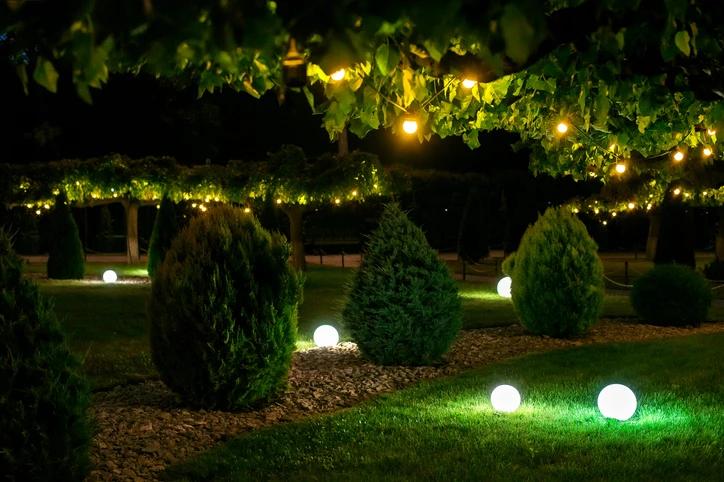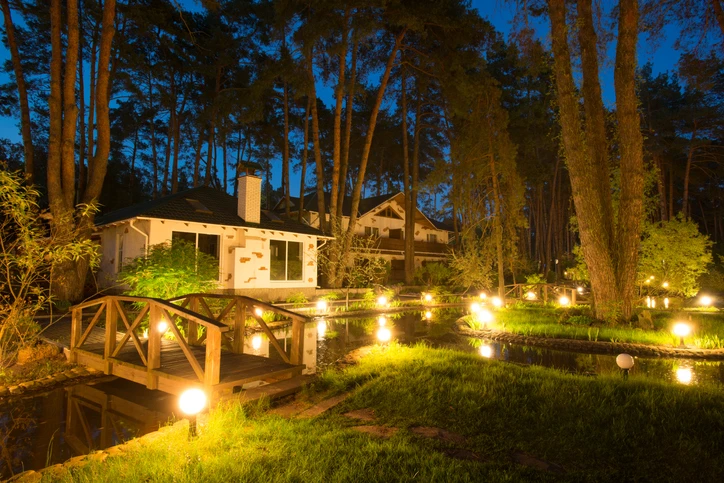Why Add Outdoor Lighting?

Make the Most of Your Yard with Functional Décor
Besides the most obvious benefit of outdoor lighting, that it illuminates the evening beautifully, there are actually many good things you get, like:
- Better curb appeal. Guests will feel welcomed by the warm glow, passersby will envy your creativity and ability to bring a stunning design to life. Add drama to existing architecture, highlight landscape features, either way, you’re making the space unique.
- Increased home value. You’ll get to enjoy the transformation while you live in the home, and if you decide to sell, you’ll benefit from prospective buyers appreciating outdoor lighting.
- More time outside. The night doesn’t have to end because the sun went down. At least, not when you have bright lights highlighting the evening.
- Safety after dark. With a blend of security and aesthetic appeal, your lights serve as a deterrent for both people and animals.
- Assistance navigating the yard. Whether you light up pathways, staircases, pools, or any other area that’s potentially dangerous, you’re creating a safer environment for your family and friends.
- Provides layout definition. Even if you don’t have a deck or patio, you can create the illusion of a dedicated space to entertain or relax with a combination of lights.

Types of Landscape Lighting Fixtures
Spotlights
Within the spotlight category, you’ve got:
- Up-lights
- Directional Lights
- Bullets
- Downlights
They’re a promising option for showcasing your favorite parts of your yard through horizontal and vertical illumination.
Floodlights
Spotlights can function as floodlights, but they’re not as bright. Floodlights are designed for security with higher wattage and wider angles.
Path Lights
Aiming light down, path lights are true to their namesake by making walkways clear.
Area Lights
In a similar category as path lights, area lights direct light downwards, although they’re useful in illuminating more space at once.
Hardscape Lights
Inorganic materials in your yard, like stones, statues, or retaining walls, are hardscape features that you could highlight.
Deck & Step Lights
Some of the fixtures used for deck lighting also work well for steps. Whether you choose one or the other, you can customize how you highlight your deck or patio.
Wall Wash Lights
While most lights tend to form an oval or wedge shape, wall wash creates even coverage over a space.
Well Lights
Also known as In-Grade Lights, these fixtures are mostly below ground level. They’re useful for walkways or driveways that allow people to pass them without causing damage, as well as for lawn lighting that lets a lawnmower go over them.
The options for landscape lighting are practically limitless. Depending on the result you want to achieve, you can use lights to create silhouettes, highlights, and accents. Mixing and matching textures, styles, and directions of your lights will add visual layers to your landscaping.
Power Options for Outdoor Lights
Depending on where your home is in the McLean area, you might have a preference for one of the three outdoor lighting power sources: Low voltage, line voltage, and solar.
Low Voltage Power
An energy-efficient option, low voltage operates at 12 volts and is easier to install as a DIY project.
Line Voltage Power
Bumping up to 120 volts, line voltage lights use an electrical conduit for high-power usage, which is common for floodlights. Professional input should be given for higher power sources to ensure your safety and that the work is to McLean code.
Solar Power
The most energy-efficient option that needs no wiring, solar-powered lights are perfect for areas with less access to electricity or those that receive a lot of natural light.
Our team of grounds pros is here for you with lighting and all sorts of lawn services that keep your property looking its best!
 Click to call
Click to call


